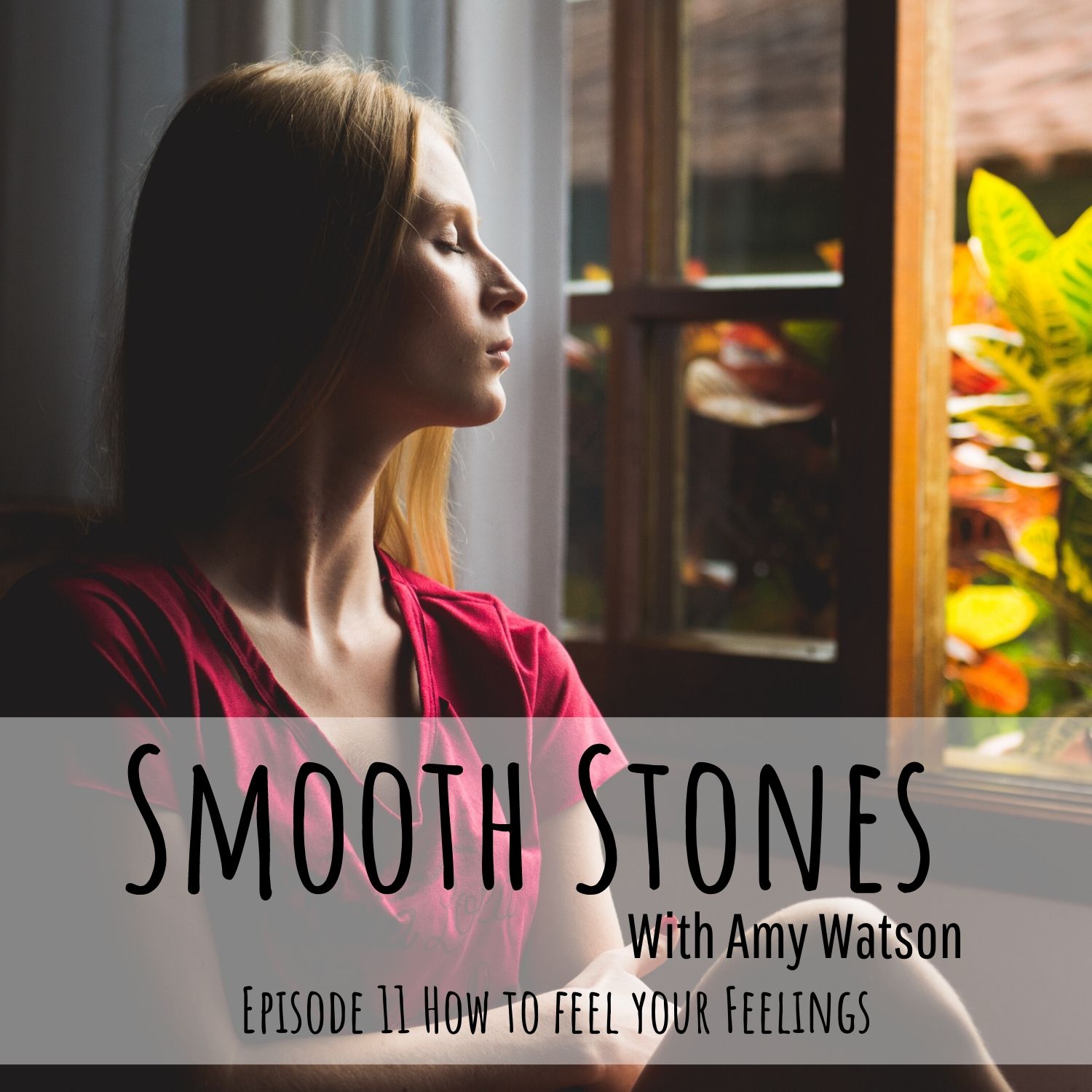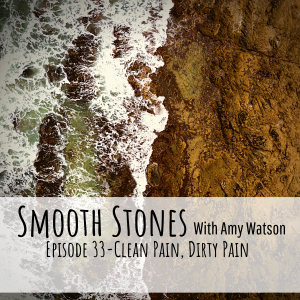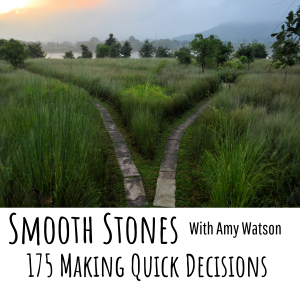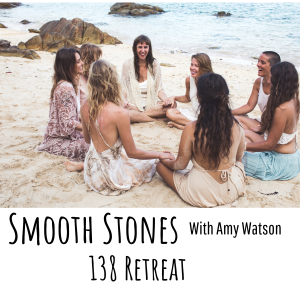Today’s episode explains why it is so important to feel our feelings. Feelings are what drive us to do anything we do, and we also avoid many things because of how we think they will make us feel.
Learning how to allow emotion gives us so much power over our lives.
I’m going to teach you a few ways to really allow the emotions, positive and negative, that arise.
If you have any questions, let me know here:
http://smoothstonescoaching.com/work-with-me
If you would like to share your baby’s story on the podcast, submit here: http://smoothstonescoaching.com/podcast-submissions
For a free 30 minute session, click here to schedule:
http://smoothstonescoaching.com/free_mini
Music by Zingdog on Pond5
photo by Natalia Figuerdo on Unsplash
Transcription
Hey, and welcome to the podcast. Today we have a great topic and I’m excited to jump into it with you because I think it’s one of the most important things that we can learn to really help us become a better version of ourselves and to really start living life fully. So last week we talked a lot about buffering, which is.
Using all kinds of different things to avoid our feelings. And today I’m gonna tell you how to feel your feelings because maybe after last week you’re thinking. Oh my goodness, I don’t even know where to start. I’ve been eating chocolate every time. I feel sad for so long that I don’t know what to do. So I am gonna tell you the reason this is so important is because everything we do is because of how we think it will make us feel.
Everything we don’t do is also based on how we think it will make us feel. So we naturally move towards positive emotions and away from negative emotions, and there’s a lot of reasons we do that. Obviously part of it is the evolution of our brains and kind of seeking pleasure and comfort kept us safe back in the caveman days like warmth and companionship and, and all of those things really meant survival.
Also in our society, we really are socialized to seek pleasure and to seek for happiness. And we’re taught outright that we should be happy and we should do all the things to create happiness in our lives. And if we’re not happy, then maybe something’s wrong with us or wrong with our life. So I wanted to use a little example of.
This Christmas season, and there’s a lot of things that we do because of how we think it will make us feel like keeping up traditions. What do traditions make us feel like? Decorating cookies. Does it remind you of home and comfort and what emotion comes up when you decorate cookies or. Put up Christmas lights, all of these things we do because we think it’s gonna bring us happy, comforting, magical emotions.
And then there’s other things that maybe we avoid, like. I personally don’t do Elf on a shelf because I just think it would drive me crazy. Yeah. It just doesn’t sound fun to me. But for other people it’s so fun and so exciting and that just goes to show you how our thoughts really create our experience.
Um, maybe there’s other things like going out in the cold weather or driving in the snow. You avoid doing because you don’t like how it makes you feel. Let’s talk a little bit about what feelings actually are. So I wanna differentiate a little bit between sensations and feelings. I’m gonna use these terms the way I interpret them, and so I’m gonna teach you that.
Now, a sensation is something that starts in the body. And it sends a signal to our brain. So that would be something like feeling hungry, feeling cold, feeling thirsty, or feeling sick. Okay, so those are sensations. Now, feelings or emotions are things that we know. Happy, sad, excited, lonely, bored. Feelings are kind of like vibrations in our body.
They always come from our thoughts. Okay, so that’s the difference. A lot of times we think that these feelings just happen to us because we don’t recognize the thoughts that’s there, but there always is one. We always create our feelings. With our thoughts, this life is full of ups and downs. We actually experience about 50% positive and 50% negative emotion throughout our life, and sometimes this may be in a day or in a whatever period of time.
We also have seasons where it just feels like it’s much more negative or seasons where everything seems to be going really well. So, I’m not gonna count it up exactly. To get the math perfect, but overall about half the time we’re gonna feel negative emotions or what we would term negative emotions, and half the time we’ll be feeling more positive emotions.
The sadness, the hard. Negative emotions really are what allow us to experience the joy and the happiness of the positive emotions, right? We really need that contrast in our life to bring out the colors, because otherwise we would just, it would be really bland to always feel kind of similar emotions.
Why this is important to understand, and this is a concept I hope to dive into a little bit more in other episodes. But if we understand this principle, we’re gonna stop wanting to be happy all the time. Like I said, we’ve kind of been socialized that we should be happy most of the time. And a lot of people who hear this 50 50 principle, they’re like, no, no, no.
I think it’s more like 80 20. I should be happy 80% of the time. And like 20% can kind of be a bummer. But what happens is when you think you should be happy all the time. You actually end up creating a lot more negative emotions in your life. I see this a lot in grief. We resist the truth of the death, so we kind of just keep wanting it not to have happened, and we resist the pain and the grief and the negative emotions.
We think that everything has gone wrong. So we add this. Other layer of negative emotion on top of already grieving. But if we can just take a breath and accept that unhappiness is a part of life, that grief is a part of life, it’s actually much easier to enjoy our life. Okay, so how do we allow these feelings?
First, I’m gonna tell you what we don’t wanna do, and just. See if you recognize yourself in any of these. I think we all do it, so there’s no judgment here. These are things that we do that probably aren’t the best way to deal with our emotions. The first one is to resist the emotion, and a really great visual that my coach Brooke created is to think about a beach ball.
And you’re swimming in the water and you’ve got this beach ball and you’re holding it under, and it works for a while, but after a little bit, it’s gonna get pretty tiring to hold that beach ball down and it’s gonna come popping back up to the surface, usually with a lot of force. And so that’s what resisting emotions feels like.
You’re just pushing it down and pushing it down. It’s always gonna come back up. I see this a lot in pregnancy after loss. So first, people resist being afraid because they think that they should be happy, like they’re pregnant again. Pregnancy is supposed to be happy. We’re supposed to be excited, but they’re anxious, and so they really don’t wanna be anxious, but they just make the whole experience worse because they’re upset with themselves for being anxious.
And they also resist being happy during pregnancy after loss because they think that if they’re happy, it’s gonna hurt more if they lose another baby, right? They don’t wanna be happy because they’re trying to protect themselves from pain. They’re trying to guard their heart. So here are these sweet mamas.
Pregnant again. And they don’t wanna be scared and they don’t wanna be happy, and they just get wrapped up in this loop and it’s really tough. And that’s why I’ve created a pregnancy after loss program. Um, so if any of that sounds familiar to you, definitely reach out to me because I love working with my pregnancy after lost clients.
They’re just. So special, and I have such a soft spot in my heart for them because I have been through three pregnancies after loss, and I just know that neither of these strategies of not letting yourself be happy, not letting yourself be anxious, they don’t work very well, it really doesn’t create a good experience during that time in your life.
Another thing we don’t wanna do is react to our emotions. This is what children do. Right now I have a two year old and a five-year-old, and they are in this battle over this little tricycle, which somehow is in the house and they ride it around on the hardwood and it really belongs to the two year old.
But the five-year-old just can’t not be on it. And so the two year old screaming. The five-year-old won’t get off and screams if you make him get off. And it’s just a whole lot of fun and they’re all just reacting to their emotions. They both want this tricycle and they both don’t wanna give it up, and there’s only one of them.
So it’s been really fun. Um, but as adults, I think we do this too. We’re really capable of throwing tantrums. They don’t look exactly the same as a toddler, although sometimes they do This. Reacting is when we dramatize things. Right. We’ve got this whole story and we freak out and we really push against the emotion.
We’re just reacting. This is the one where it often seems like there is no time for a thought. Something happens, we react and people would argue. I don’t even think there’s a thought in there. There’s not enough time, but there always is a thought. It’s like when someone cuts us off in traffic and in a snap, we do whatever we do.
When someone cuts us off in traffic in the moment, you know what you do and that’s reacting and that usually doesn’t feel good. That’s a lot of us will regret. How we acted when we just let our emotion drive us that way. And the last thing we don’t wanna do is the avoiding. And that’s what we talked about last week with, with the buffering.
It’s not allowing ourselves to feel, and this behavior doesn’t serve us and has a negative effect on our lives. This is the chocolate and the wine, and the Netflix, and the scrolling our phone. And staying busy so we don’t have to feel our emotions buffering, will not move us closer to our goals. Whatever those goals are, whether you have like a work goal or a fitness goal or an emotional goal, like just a self-development goal or grief work, any of that buffering.
Isn’t gonna move us towards it. That’s why it’s really not a great strategy to use. Now again, like I said, anything that you find yourself doing in these categories, it’s okay. The first thing we need to do is become aware of what we’re doing and don’t judge it. Just notice it. And then I’m gonna show you here how to actually allow and process through emotions.
And this is something that takes practice, but once you learn it, it’s such a transformative skill to have. Now, when we’re grieving, it can be really important to allow ourselves to feel the positive emotions, but for a lot of people, the thing they’re most scared of is to allow negative emotions and. We kind of feel like we’re gonna head into this black hole that we’re never gonna get out of, or we think there’s no way we can stand it.
Like it just will not be tolerable to feel this feeling. So it’s better to just avoid it or try to outrun it, but really if we go towards it and we allow it, We’ll find out that it’s really not as bad as what we thought it was ’cause our brain is really good at making things big and scary. There are lots of different ways that we can allow our emotions.
I’m gonna teach you a few that really work for me and that I’ve been taught that have been so helpful. And the first one is, Kind of funny, but it really helps you slow down and recognize that these vibrations that we’re so afraid of aren’t actually. That painful when you break it down and this idea is to explain the emotion like you were telling a Martian, or I like to think of a robot and Star Wars is coming out next week, say C three po.
Or data from Star Trek. If that shows how big of a nerd I was back in high school, but someone who has never experienced human emotions. How would you describe this feeling? So we asked some questions like, what does it actually feel like and where in your body do you feel it? Does it feel fast or does it feel slow?
Does it buzz or quiver? Does it throb? Does it have a color? What color would you use to describe this emotion? This can be really hard for a lot of people, especially at first because we’re so detached, I think from our emotions a lot of the time. But if you especially even write it down, this can be such a good exercise to do, so say anxiety or like stage fright.
Like you have something coming up where you have to speak in front of people. What is that feeling like? For me, it’s in the pit of my stomach and it’s tight and it feels kind of slow, but constant. And I would describe it probably a sum, um, shade of green. And just because it’s so much in my stomach, I think.
Actually a lot of people, if you sit and do this, that feeling of anxiety or nervousness feels a lot like excitement. So if you described excitement, where would you feel it? Your heart’s beating faster. Your stomach has butterflies. It’s kind of the exact same thing, but we hate anxiety and we love excitement.
So really get in your body and out of your mind because a lot of times when we describe feelings, we wanna give a whole bunch more thoughts, but go in your body and describe it like you would to a robot or an alien. And it’s really an amazing exercise to do. Um, another way to. Feel and allow our emotions is to become the watcher.
And we’ve talked about this a little bit before, but it’s where we step back a little bit and we witness our emotions almost like we’re on the other side of the room from them, like we’re a little bit outside of ourselves. It creates a little bit of distance and you can recognize the thought you’re choosing.
How it’s creating that emotion. So if we keep going with this example of stage fright, you can step back a little bit and say, why am I so anxious? What’s going on? Just come at it with the curiosity and recognize, oh, because I’m afraid people are gonna laugh at me, or I’m afraid I’m gonna pass out, or that I’m not gonna do a good job.
And that’s why I’m afraid, right? Because going out on stage is just a circumstance. How many people are in the audience? That’s a circumstance. And some people love it and get so much energy from it and other people, it’s just terrifying. And so just recognize those thoughts and say, what I wonder what’s going on in my mind that’s creating so much anxiety for me.
Another way we can feel our emotion is to hold it in a place of peace. This is another way to say that you hold space for your emotion. So a good visual for this one is, To almost hold it in your hand. Imagine in your mind that you’re holding this emotion in your hand, and just study it with curiosity.
Allow it to be there. Again, if you’re afraid, if you’ve got stage fright, what if you just let it be there? You know, you’re gonna get on that stage. You know that whatever’s gonna happen is gonna happen, and you just let that nervousness be there. You almost embrace it. So you just let it be there. You keep doing your thing, you wrap it in warmth and allow it to stay.
You wanna open up and even move towards the emotion, whatever this will be, and I think this is. So useful when we do have those grief feelings or anger or shame, really allowing ourselves to feel it is so powerful because when we’re afraid of it and we’re avoiding it, it just becomes so big and unmanageable.
But when we bring it in close, It’s just a completely different experience and we realize that we can handle way more than what we thought. So this takes practice and a lot of people are probably thinking, okay, Amy, how do I even do that? I am busy. I’ve got a lot going on. What does this even look like in reality?
Am I supposed to stop and take half an hour to think about my feelings? And that would be great if you can. I think having some sort of mindfulness practice or breathing meditation, prayer, I. Anything that you can do on a daily basis. Of course, I recommend doing a thought download every day and kind of getting everything outta your mind, but it doesn’t have to take a lot of time.
And like I said before, sometimes you’re really gonna do this after the fact at the beginning, and as you practice more, you’ll be able to recognize things in the moment. We just have to keep reminding ourselves over and over to allow. The feelings and to move with them instead of going back into those reacting and resisting and buffering behaviors, especially if you’ve been doing those for a long time, you’ve kind of created a pathway in your brain of how you deal with this emotion.
You really have to stop and redirect your brain so that you. Can allow those emotions. Do you think? You don’t have time? I promise you even trying it for a couple of minutes a day or when you’re in kind of a more intense situation, just take a breath and allow those emotions again, you can carry them with you and just say like someone going on stage.
I am anxious, I’m afraid, and I’m just gonna do it anyway. And I’m gonna go ahead and bring it with me. I’m gonna carry it out on stage with me, and this is really powerful. So try it and if you have any more questions and you’re kind of thinking, this sounds amazing, but I’m really, I need help because I’ve got.
A problem I don’t think I can solve on my own. Please reach out to me. I’ll have links in the show notes. You can find me on Instagram. I am Amy Dooo Stones Coaching. I would love to talk you through how to feel your emotions, how to allow them, and then how to let them go if it’s time for them to go, because this is what we wanna do is accept.
The positive emotions, the negative emotions, all of the parts of being human, but really let go of any of those extra layers of suffering that we’re putting on top of it, because those are just never necessary. They seem really necessary to our brain, but I’m telling you now that you can let go of them and you can live a life more fully where you.
Experience. All of these emotions, the lows don’t seem so low, and the happier times really are that much brighter because you’re experiencing all of it and you’re allowing yourself to really laugh and really cry and everything in between, and it’s such a great way to live. So, Thank you for sticking with me and I hope this has been really helpful.
If you have any questions, please reach out to me anytime. I would love to talk to you and I have some free 30 minute sessions open. If you would like some help with this, I’d love to talk to you. The link will be down in the show notes, so have a great day. And we will talk to you next time.




